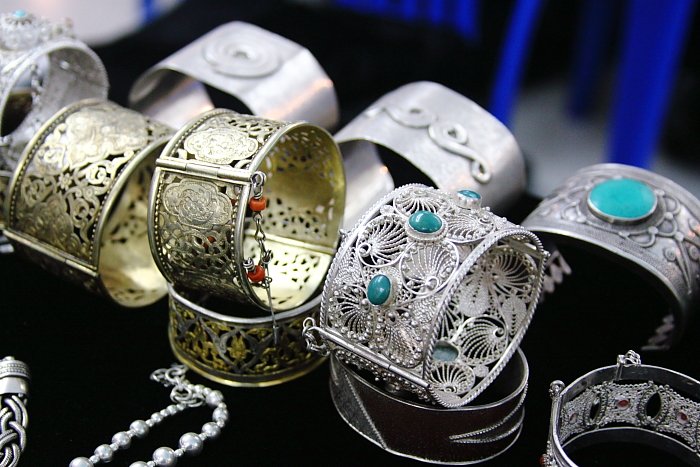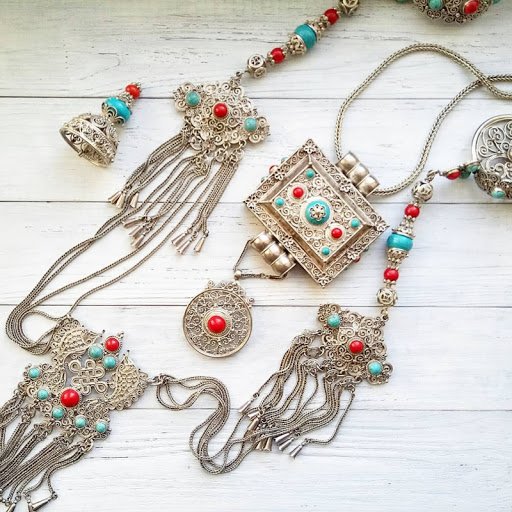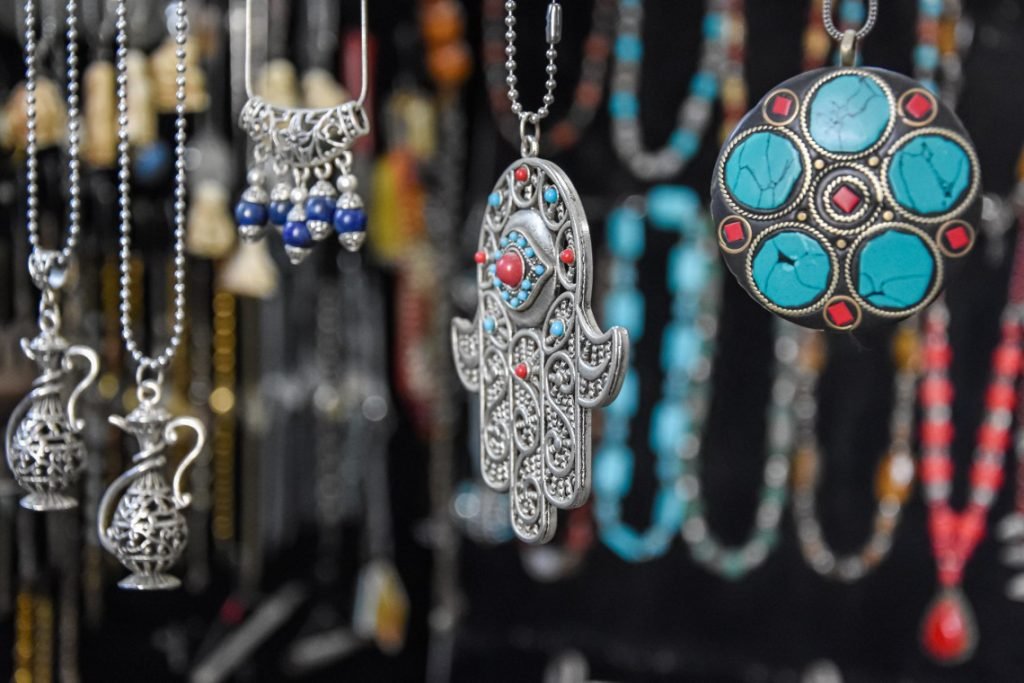Magical Uzbek jewellery
Jewelry craft in Uzbekistan has a long history. Probably, in all early civilizations, the fangs and claws of animals, feathers of birds were used as simple amulets. In the Bronze Age, low gems, bronze bracelets and hairpins with figured tops, of very fine work, are found on local settlements. Antiquity is already the highest level of jewelry, which is confirmed by unique findings. The late Middle Ages is represented by the greatest number of various products.
Of course, over the centuries, tastes for jewelry, albeit slowly, have changed. If we talk about the general features of Uzbek jewelry of the 19th – early 20th centuries, then these are archaic forms, their connection with ancient cult-magic representations, complex composition, the use of various types of techniques (forging, chasing, gilding, filigree, grain, enamel), an abundance of inlays and pendants.
Jewelry was worn by both men and women. Jewelry was an indicator of social status, belonging to a particular age category. The main event, when the whole set of jewelry was used, was, of course, weddings.

The most popular metals that jewelers worked with are silver and gold. For less affluent people, jewelry was made from cheap alloys – copper and brass. Also, artisan jewelry was made of these materials, which in turn decorated the house and gave a special style and comfort to each house.
The soft luster of silver resembles moonlight, so silver was considered the metal of the moon. The moon, in turn, according to mythological representations, was the embodiment of the feminine, therefore it is no coincidence that silver is the most popular metal for women’s jewelry: a woman wearing silver seemed to fall under the protection of this heavenly luminary. Hands humiliated with silver rings were considered ritually clean.
The brightness of gold was associated with the Sun, a masculine sign, so men preferred this metal. He was associated with ideas about protection, a long, healthy and prosperous life, as well as strength and power.
The widespread use of low-cost alloys has also been associated with their properties, often medicinal. For example, it was believed that copper helps with dislocations, relieves joint pain, and reduces pressure.
The magical power of metal was organically supplemented by the no less magical properties of stones – precious and semiprecious, each of which was called to protect in its own way from the evil eye, diseases and harmful forces. People were so convinced of the healing properties of stones that they even took them inside as a medicine, in the form of crushed powder.
Red stones are perfectly combined with silver, and therefore carnelian and coral were the most popular in Central Asia. Red stones were designed to stimulate human energy, strengthen the protective functions of the body. It was the color that provided their magical charms – red, as a symbol of fire, the Sun, blood, has long been associated in the East with the concept of protective power.
To this day, the most revered and popular stone among jewelers of Uzbekistan remains the cornelian, which was considered a stone of love, health, attracting well-being. Carnelian, which has absorbed all shades of red – from pinkish-orange to brown-brown – is found in almost all types of female silver jewelry. It was also believed that carnelian promotes a safe birth, protects children. It is with this stone that men’s rings were most often encrusted. According to legend, the Prophet Muhammad said: “He who wears a carnelian ring, he constantly abides in prosperity,” “Wear a ring with a carnelian, for truly he casts out poverty.”

Coral was equally popular – necklaces made of this stone were given to women, wishing them numerous offspring; it was worn by those who were afraid to lose their husband’s love, as well as childless, believing in its mysterious fertilizing power – it was believed that children’s souls were enclosed in coral beads. Many small coral beads in one decoration seem to symbolize wealth in the house and numerous offspring. Sometimes corals were placed in a crib to scare away evil spirits.
Turquoise is a man’s stone, a symbol of victory. However, women appreciated her for the rich blue color that perfectly suits brunettes.
The multi-color stones were balanced by the soft flickering of pearls and nacre. Like silver, the latter were considered associated with the moon, and, accordingly, patronized the woman. Pearls were also considered a stone, bringing prosperity to the house.
In general, jewelry was not just decoration. Their main function is magical protection, a guarantee of numerous offspring.
Distinguishing jewelry traditions by region
Indeed, regional differences are significant. By the 19th century, when there were three states on the territory of Central Asia – the Bukhara emirate, the Kokand and Khiva khanates, there were at least four jewelry schools: Khiva, Karakalpak, Bukhara-Samarkand, Ferghana.
So, Khiva jewelry was distinguished by particularly delicate work, the use of cloisonne enamel, numerous stamped pendants-grains, rich in inlay. Many Karakalpak products are related to Khiva in form, but are completely different in style. They are characterized by brutality, massiveness and conciseness.
Sets of jewelry of Bukhara, Samarkand and Tashkent have many common features – the forms and techniques are similar. The jewelry art of the Ferghana Valley absorbed a certain influence of neighboring East Turkestan. Ornaments made in rural areas differed from urban ones in the worst quality of metals and rude work.

Until now, in remote regions of Uzbekistan, for example, near Baysun Kungrads, woven bead jewelry that women make themselves is popular: beads were considered a strong amulet, and the plurality of beads was associated with the wishes of numerous offspring.
Throughout the twentieth century, the fate of traditional jewelry was unenviable – private production was outlawed, the more illegal traffic of precious metals and stones was punished. Jewelry art developed within the framework of state factories. Of course, professional jewelers tried to study the richest traditional heritage, to create jewelry based on the old ones, which became both an object of mass production and exhibition samples. At the same time, a line of non-traditional jewelry was formed.
Uzbekistan’s independence became a real incentive for jewelers – now they again have the opportunity to work independently. Currently, we can talk about many trends in jewelry. This imitation of classic antique products, and the use of elements of traditional ornament on modern forms, and a kind of international style (already familiar European classics), and author’s jewelry avant-garde. All this diversity can be seen in local showrooms or at regularly held craft fairs in the capital.

